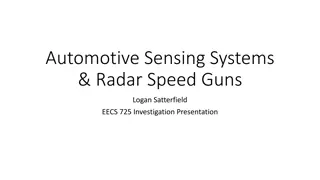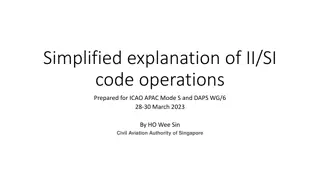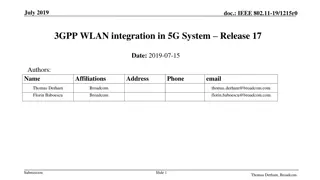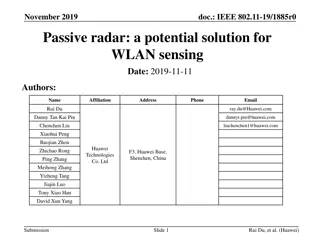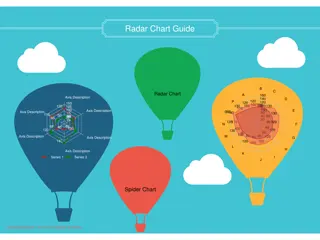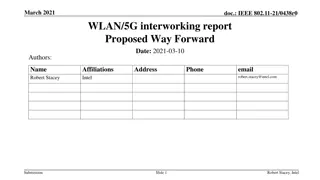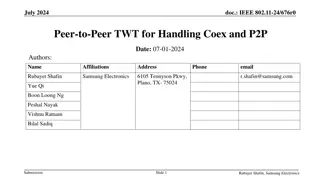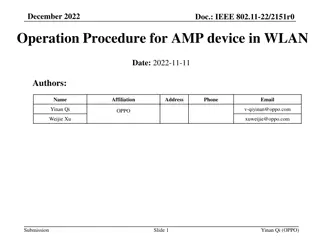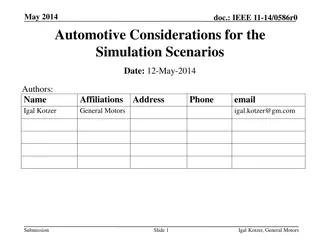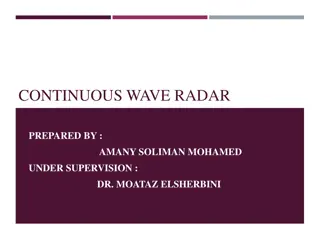Radar Function Integration in WLAN: January 2019 Discussion
The January 2019 document IEEE 802.11-19/0080r0 explores integrating radar functions into WLAN to enhance coexistence. The proposal outlines various options, including modified schemes and dedicated indication methods for radar operation within WLAN frameworks. It emphasizes the need for feedback on potential solutions. Additionally, the document discusses monostatic and bistatic radar systems, highlighting the advantages of multistatic radar for target detection. Different proposed schemes are evaluated, considering their pros and cons in supporting radar capabilities within WLAN devices.
Download Presentation

Please find below an Image/Link to download the presentation.
The content on the website is provided AS IS for your information and personal use only. It may not be sold, licensed, or shared on other websites without obtaining consent from the author.If you encounter any issues during the download, it is possible that the publisher has removed the file from their server.
You are allowed to download the files provided on this website for personal or commercial use, subject to the condition that they are used lawfully. All files are the property of their respective owners.
The content on the website is provided AS IS for your information and personal use only. It may not be sold, licensed, or shared on other websites without obtaining consent from the author.
E N D
Presentation Transcript
January 2019 doc.: IEEE 802.11-19/0080r0 Further discussion for WLAN Radar Date: 2019-01-03 Name Affiliation Address Phone Email Tony Xiao Han Huawei Technologies Tony.hanxiao@huawei.com Rui Du Huawei Technologies Wei Lin Huawei Technologies Ross Jian Yu Huawei Technologies Yan Xin Huawei Technologies Submission Slide 1
January 2019 doc.: IEEE 802.11-19/0080r0 Outline Background and motivation Opt 1. No change for the Spec Opt 2. Scheme in [2] Opt 3. Modified scheme based on [2] Opt 4. Dedicated explicit indication scheme based on [2] Summary and comparison Conclusion Submission Slide 2
January 2019 doc.: IEEE 802.11-19/0080r0 Background and motivation As described in [1], radar use-case in unlicensed mmWave starts to gain interest in the industry for many applications. Hence, in [1, 2], radar is proposed as part of the WLAN framework, in order to achieve better Coexistence and sharing between radar function and WLAN function. In this proposal, we want to summarize and analyze all possible solutions considered so far to include radar function in WLAN, and ask for the feedback from the group. Submission Slide 3
January 2019 doc.: IEEE 802.11-19/0080r0 Background and motivation Monostatic radar is a type of radar in which the transmitter and receiver are collocated. Bistatic radar is the name given to a radar system comprising a transmitter and receiver that are separated by a distance comparable to the expected target distance. A system containing multiple spatially diverse Monostatic radar or Bistatic radar components with a shared area of coverage is called Multistatic radar. The Multistatic radar could be used to do, e.g., target detection, with the following advantages comparing to Monostatic radar: Multistatic radar is able to localize the target with only a single time radar signal transmission Multistatic radar system, which include multiple receivers at different locations, is more robust than Monostatic radar on target detection. Bistatic Radar Multistatic Radar Submission Slide 4
January 2019 doc.: IEEE 802.11-19/0080r0 Opt 1. No change for the Spec A possible scheme without changing the Spec The radar STA (i.e., STA with radar function) could send DMG CTS-to-Self to set the NAV, Then radar STA could transmit any radar signal during the TXOP. Pros No change for the Spec (especially in the late phase of the 11ay project) Could work for Monostatic radar Cons May not robust enough, since the WLAN device may miss the DMG CTS-to-Self and fail to set the NAV, and then only energy detection could be used for the following radar signal. Does not support Bistatic/Multistatic radar. Since the transmitter and receiver are in different devices for Bistatic/Multistatic radar, so without explicit indication, the receivers do not know the PPDU is for radar, then do not know when to turn on/switch to radar functionality, and do not know when and where to receive the radar signal. Submission Slide 5
January 2019 doc.: IEEE 802.11-19/0080r0 Opt 2. Scheme in [2] Scheme in [2] including some modification for the Spec, e.g., The DMG PHY and EDMG PHY is used to implement radar functionality Setting RA=TA for some types of frame (e.g., SSW), and this may indicate for radar functionality Adding TRN for some types of frame (e.g., SSW), which is not allowed in the Spec for now Pros More robust than Opt 1, since radar signal is included in a DMG/EDMG PPDU. Could work for Monostatic radar Cons EDMG PHY is not a good choice, since 11ad STA cannot understand 11ay preamble and so on (e.g., MAC header including RA, TA, and Duration fields), and cannot set NAV. Hence, 11ad STA may potentially transmit, which could create interference to radar signal. Receiving a DMG PPDU with RA=TA, the unintended STAs do not explicitly know it s radar PPDU/TXOP, then the STAs only keep quiet during the TXOP, but cannot go to sleep (or go to sleep with concern/risk), since the TXOP holder (e.g., PCP/AP) may transmit to them. But keeping awake and receiving each following PPDU is wasting the energy of the unintended STAs. Does not support Bistatic/Multistatic radar. Since the transmitter and receiver are in different devices for Bistatic/Multistatic radar, so without explicit indication, the receivers do not know the PPDU is for radar, then do not know when to turn on/switch to radar functionality, and do not know when and where to receive the radar signal. Slide 6 Submission
January 2019 doc.: IEEE 802.11-19/0080r0 Opt 3. Modified scheme based on [2] Enhanced scheme based on [2] Only the DMG PHY is used to implement radar functionality Using RA=TA for few types of frame (e.g., SSW) as explicit indication for radar PPDU/TXOP Adding TRN for some frames (e.g., SSW) Pros More robust than Opt 1&2, since radar signal is included in a DMG PPDU and explicitly indicated. The unintended EDMG STAs explicitly know it s radar PPDU/TXOP, then the STAs could go to sleep without any concern/risk, since the TXOP holder (e.g., PCP/AP) will not transmit to them during the TXOP. Cons It is a misusing of RA=TA and will cause problem in the future. E.g., if we want other function/indication, and together with setting RA=TA at the same time, then it will cause problem for radar functionality (e.g., will cause false alarm for Bistatic/Multistatic radar) and for EDMG STA (will treat it as radar PPDU/TXOP, which is not, and will improperly go to sleep). Still does not work for Bistatic/Multistatic radar. Since the RA=TA, i.e., RA does not indicate the actual receiver, hence the receiver could not receive this radar PPDU. Submission Slide 7
January 2019 doc.: IEEE 802.11-19/0080r0 Opt 4. Enhanced scheme based on [2] Enhanced scheme based on [2] Only the DMG PHY is used to implement radar functionality Adding dedicated explicit indication for radar PPDU/TXOP E.g., 1 reserved value in Scrambler Initialization field (in Table 46 in [3]) in control mode PPDU Adding TRN for some frames (e.g., SSW) Pros More robust than Opt 1&2&3, since radar signal is included in a DMG PPDU and dedicated explicitly indicated. The unintended EDMG STAs explicitly know it s radar PPDU/TXOP, then the STAs could go to sleep without any concern/risk, since the TXOP holder (e.g., PCP/AP) will not transmit to them during the TXOP. Could work for Monostatic radar and Bistatic/Multistatic radar Will not cause any further problem in the future Cons Need explicit indication (if we call this is Cons/drawback ) Submission Slide 8
January 2019 doc.: IEEE 802.11-19/0080r0 Summary and comparison Monostatic radar Bistatic/Multistatic radar Spec change Robustness/Coexistence Power saving Low. Yes No No No Opt 1. No change for the Spec since the WLAN device may miss the DMG CTS-to-Self and fail to set the NAV (could work) E.g., DMG CTS-to-Self, then any radar signal Medium. Yes No No Yes Opt 2. Scheme in [2] E.g., EDMG PHY, RA=TA (non explicit indication ), adding TRN DMG PHY and Better than Opt 1. But EDMG PHY is not a good choice Medium. Yes No Yes Yes Opt 3. Modified scheme based on [2] Better than Opt 1&2. The unintended EDMG STAs explicitly know it s radar PPDU/TXOP, then the STAs could go to sleep without concern/risk, E.g., DMG PHY, explicit indication RA=TA for few types of frame , adding TRN But it is a misusing of RA=TA and will cause problem in the future. by setting any High. Yes Yes Yes Yes Opt 4. Dedicated explicit indication scheme based on [2] Better than Opt 1&2&3 The unintended EDMG STAs explicitly know it s radar PPDU/TXOP, then the STAs could go to sleep without concern/risk, E.g., DMG PHY, dedicated explicit indication, adding TRN any Submission Slide 9
January 2019 doc.: IEEE 802.11-19/0080r0 Conclusions This contribution summarizes and analyzes all possible solutions considered so far to include radar functionality in WLAN After comparison, it seems that the Opt 1 could work without changing the Spec. If the group agrees to change the Spec, then the Opt 4 is a better solution. Submission Slide 10
January 2019 doc.: IEEE 802.11-19/0080r0 Straw Poll/Motion 1 Which option do you prefer for adding radar functionality? (The corresponding draft text will be provided if Opt 4 is preferred) Opt 1. No change for the Spec E.g., DMG CTS-to-Self, then any radar signal Opt 2. Scheme in [2] E.g., DMG PHY and EDMG PHY, RA=TA, adding TRN Opt 3. Modified scheme based on [2] E.g., DMG PHY, explicit indication by misusing RA=TA, adding TRN Opt 4. Dedicated explicit indication scheme based on [2] E.g., DMG PHY, dedicated explicit indication, adding TRN Abstain Submission Slide 11
January 2019 doc.: IEEE 802.11-19/0080r0 References [1] 11-18-2094-00-00ay-wlan-radar.pptx [2] 11-18-2095-00-00ay-wlan-radar-annex.docx [3] Draft P802.11ay_D2.1.pdf Submission Slide 12






